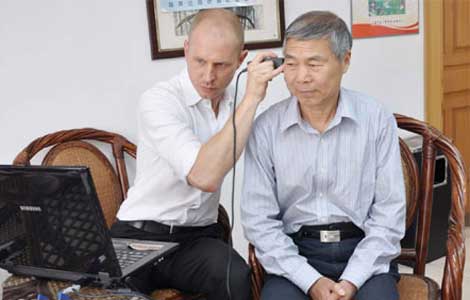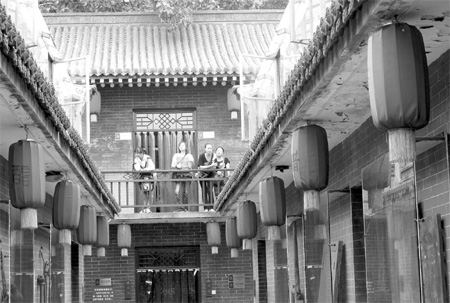Food
Tart and true
Updated: 2011-08-21 07:56
By Eric Jou (China Daily)

|
Visitors to the Dong Hu aged-vinegar factory in Taiyuan will find the architecture as traditional as the vinegar-making process. Eric Jou / China Daily |
It's sour, it'll clear out your sinuses, it's Shanxi old vinegar, one of the oldest food products from the region. It was also at the center of another food controversy recently. Eric Jou visits Taiyuan, Shanxi province, to find out what��s real and what's not.
Shanxi laochen cu, or aged vinegar from Shanxi, is known not only as a condiment and ingredient widely used in Chinese cuisine, but it is recorded in Chinese pharmacopeia as having many health benefits. It is also listed as a cultural heritage by the government, in recognition of its long history of at least 600 years.
Recently, a highly placed official in the watchdog body on quality control accused some producers of adulterating the product with additives, an allegation that was later denied. But it was enough to send consumers into a dither, jittery as they already are with the series of food scandals that has hit in recent years.
Shanxi aged vinegar is widely consumed, especially as a dip for the dumplings or jiaozi that the whole of China loves so much. So how can you tell if it's the real thing?
We visited the Dong Hu factory in Taiyuan, Shanxi and decided to explore at source. Dong Hu has been making and selling aged vinegar for more than 60 years, and the plant still makes the vinegar the traditional way.
Qin Jinji, deputy manager of operations at the Shanxi Mature Vinegar group, says Shanxi vinegar is very different from regular Chinese vinegar such as Zhejiang vinegar, and it is also vastly different from balsamic vinegar.
"Vinegar has a series of health benefits, but Shanxi mature vinegar is in a league of its own," Qin says. "It has all the nutrition of regular vinegar, and it's much more than a condiment."
With the recent allegations of additives and acid added into "stock", it would have been safe to assume Shanxi mature vinegar also took a hit in sales. But Qin says that's not the case. He says people know the difference, and once you've had the Shanxi aged vinegar, you will be able to tell the difference immediately.
It's all about the process, and we were led through the production line for a closer look.
Shanxi mature vinegar is mainly sold as three different vintages. The manufacturing process takes about a month, but the product still needs to be sun "baked" for at least a year before it can be called aged vinegar. The drying process evaporates the water, leaving a pure, rich brew.
To start making the vinegar, five ingredients - chaff, peas, barley, bran and sorghum - are boiled and then fermented to make a strong baijiu or white liquor. That done, the making of the vinegar continues with the wine left to bask in the sunroom to keep the fermentation going, until vinegar forms.
Where other vinegar-makers are content to stop here, Shanxi aged-vinegar producers go a few steps further.
Here, the vinegar is left to ferment and mature for at least three years before it can be sold. So the "youngest" vinegar would already have gone through a four-year process of manufacture and maturing.
"Vinegar-makers know how to make wine, but wine-makers don't know how to make vinegar," says Hao Jianhua, a guide working at the Dong Hu vinegar factory. That's because the vinegar makers carry the process forward and they look for more than just the alcohol in the brew.
Hao, who has worked for Dong Hu for several years, knows all about the ins and outs of the vinegar-making process and he offered some pointers.
Good Shanxi vinegar should be aged at least three to eight years, he says.
"The best vinegar should have a strong aroma that can clear the sinuses; it should be tart and sour and powerful, In contrast, the taste should be light, clean and crisp with a touch of natural sweetness."
Hao says the color should be dark, translucent with a purplish tinge. It should have a viscosity that makes it cling to the surface of the bottle or glass instead of pouring straight like water.
Vinegar brew master Qu Zhenzhuang has been making Shanxi mature vinegar over 30 years, and he is now passing on the art of making the vinegar to his disciples. Despite the changing times, he says, the steps used to make Shanxi vinegar have remained the same.
"Back when I started making the vinegar, I had no choice. It was a job and I did it. It was heavy manual labor and there was little reward," Qu remembers.
"Now, it's still the same back-breaking labor, but it pays much more and I'm able to see people enjoy my product. Some of the machines have been changed but the same techniques are still required for distilling the mash (the mix of ingredients used to make Shanxi matured vinegar).
"It hasn't changed too much since I started 30 years ago."
You can contact the writer at ericjou@chinadaily.com.cn.
|
Shanxi aged vinegar is dark, translucent with a purplish tinge and it should have a visible viscosity. At Dong Hu, the vinegar is left to ferment and mature for at least three years before it can be sold. |
E-paper

Blue economy gets a lift
Coastal areas of Shandong, Zhejiang and Guangdong to spearhead sector development.
The light touch
Long way to go
Outdoor success
Specials

Star journalist remembered
Friends, colleagues attended a memorial service to pay tribute to veteran reporter Li Xing in US.

Hot pots
Tea-making treasures catch the fancy of connoisseurs as record prices brew up interest

Hear we go
Polish Audiologist helps thousands of Chinese hear for the first time.


